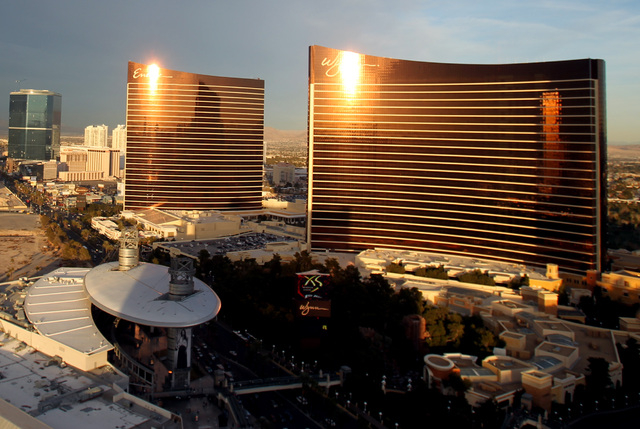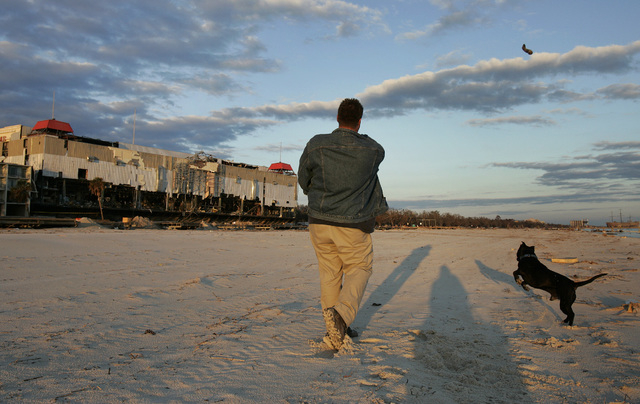Decade covering casino industry anything but boring
CityCenter was nothing more than conceptual renderings and a $5 billion idea when I rejoined the Review-Journal business staff 10 years ago.
You could still place a wager at the Stardust and the Frontier, Macau was the world’s third-largest gaming market, Internet poker was becoming more than a curiosity and the idea of casinos in Ohio and Maryland was far-fetched.
Not to sound like a mix between Forrest Gump and Zelig, but I’ve enjoyed having a front-row seat to some of the big events that have remade the gaming industry since returning to the newsroom in November 2004.
During my first five-year stint at the newspaper I covered the opening of The Mirage. Steve Wynn’s $565 million hotel-casino was unveiled in 1989 as the Strip’s first new resort in more than a decade. Many said it would fail given its record-breaking budget.
In 2005, I covered the opening of Wynn Las Vegas, which cost $2.7 billion. No one doubted its success.
The past 10 years covering gaming nationally and internationally have been nothing short of a theme park thrill ride that Disney’s greatest designers couldn’t conjure.
Las Vegas hit an apex in 2007, only to be brought low by recession. The market is slowly recovering.
Macau has grown into a $45.2 billion annually gaming conglomerate that surpassed Las Vegas in 2006. The Chinese enclave has taken a nosedive in recent months, but most analysts have little doubt of a recovery.
Meanwhile, gaming has spread across the U.S.
I covered the opening of Ohio’s first full-scale casino, the Horseshoe Casino Cleveland, in 2012. Voters in 2009 approved gaming there after countless previous attempts.
In May, I stood on a hotel-casino site in National Harbor, Md., about 8 miles from Capitol Hill. MGM Resorts International is building a $1.2 billion complex so close to Washington, D.C., it will have a view of the Washington Monument.
Gaming has become a national industry.
The American Gaming Association released a study during the Global Gaming Expo that showed casinos in 40 states annually contribute $240 billion to the U.S. economy, support 1.7 million jobs and generate $38 billion in taxes — a far cry from 10 years ago.
But gaming still has issues.
Las Vegas casinos aren’t controlled by mobsters as they were in the 1960s and 1970s, but crime remains a concern.
Computer attacks on Las Vegas Sands Corp. and Affinity Gaming this year show that casinos are not safe from cybercriminals. Meanwhile, the U.S. Treasury Department’s Financial Crimes Enforcement Network warned gaming companies to avoid money laundering implications by better tracking how gamblers move funds in and out of cashiers cages.
Critics believe the gaming industry doesn’t do enough to create awareness of problem gambling. Anti-tobacco advocates want Strip casinos to outlaw smoking, noting casinos elsewhere succeed despite smoking bans.
Gaming saturation — primarily in the northeast — is a concern as Massachusetts joins New Jersey, Delaware, New York, Maryland, Ohio and Pennsylvania in offering casinos.
The topic is a roller coaster.
I’ve interviewed countless gaming industry leaders and business icons over the years — too many to list.
The late gaming attorney Bob Faiss, however, stands out as one of the most valued resources offered to any journalist. He was an encyclopedia of knowledge on gaming law and the industry. There was never a pretense that he was trading information in exchange for a favorable story. I wrote his obituary earlier this year through tears.
The ordinary people I met in October 2005 in Biloxi, Miss., and New Orleans, two months after Hurricane Katrina, were impressive. Former Review-Journal photographer John Locher and I traveled to the Gulf Coast to report on the local gaming industry’s devastation.
Many of those we talked with lost their homes and their livelihoods but not their perseverance. They had amazing stories of survival. It was rewarding as a journalist to be there and doubly rewarding to return for the storm’s one-year anniversary.
The gaming beat also has its humorous moments.
In 2007, Review-Journal photographer Jeff Scheid and I traveled to Macau to report on the market’s growth. While checking out of the Venetian Macau we spotted a familiar person at the front desk — Caesars Entertainment (then-Harrah’s Entertainment) Chairman Gary Loveman.
Imagine his horror: disheveled after a 15-hour flight and running into journalists from Las Vegas.
“What are you doing here, Gary?” was my question. Harrah’s didn’t operate casinos in Macau.
“Just checking things out,” Loveman said, hustling off with his assistants in tow. That afternoon, Harrah’s paid $578 million for the Macau Golf Course with hopes of developing a hotel-casino complex on the land. It never happened.
This assignment always has been about adapting to change. The word also best describes my career, which had me working in different aspects of communications for 13 years between my Review-Journal stretches.
In 2005, then-MGM Mirage paid $7.9 billion for the Mandalay Resort Group. A month later, Harrah’s Entertainment bought Caesars Corp. for $9 billion, later taking the Caesars name.
I’m now following the buyouts of Nevada’s largest slot machine manufacturers. Italy-based GTECH Holdings is paying $6.4 billion for International Game Technology; New York-based Scientific Games Corp. is buying Bally Technologies for $5.1 billion.
The more things change, the more they stay the same.
Some believe the Strip would be better off if the Frontier and Stardust hadn’t been imploded. The Frontier site has been empty since November 2007. It was given a hint of new life this summer through its purchase by Australian billionaire James Packer.
The Stardust was blown up in May 2007 for Echelon. That project halted construction in August 2008. We’re still waiting for Genting Berhand to commence building Resorts World Las Vegas there. The Malaysia-based company bought the site in March 2013.
Recovery and change underscored the gaming industry long before the Frontier and Stardust became rubble.
It will continue to be part of my coverage over the next 10 years.
Howard Stutz’s Inside Gaming column appears Wednesdays and Sundays. He can be reached at hstutz@reviewjournal.com or 702-477-3871. Follow on Twitter: @howardstutz.




















